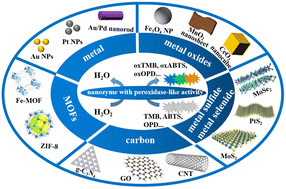Recent advances in colorimetric sensors based on nanozymes with peroxidase-like activity
Abstract
Nanozymes have been widely used to construct colorimetric sensors due to their advantages of cost-effectiveness, high stability, good biocompatibility, and ease of modification. The emergence of nanozymes greatly enhanced the detection sensitivity and stability of the colorimetric sensing platform. Recent significant research has focused on designing various sensors based on nanozymes with peroxidase-like activity for colorimetric analysis. However, with the deepening of research, nanozymes with peroxidase-like activity has also exposed some problems, such as weak affinity and low catalytic activity. In view of the above issues, existing investigations have shown that the catalytic properties of nanozymes can be improved by adding surface modification and changing the structure of nanomaterials. In this review, we summarize the recent trends and advances of colorimetric sensors based on several typical nanozymes with peroxidase-like activities, including noble metals, metal oxides, metal sulfides/metal selenides, and carbon and metal–organic frameworks (MOF). Finally, the current challenges and prospects of colorimetric sensors based on nanozymes with peroxidase-like activity are summarized and discussed to provide a reference for researchers in related fields.

- This article is part of the themed collections: Analyst Review Articles 2023 and Analyst HOT Articles 2023


 Please wait while we load your content...
Please wait while we load your content...